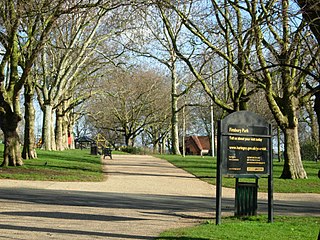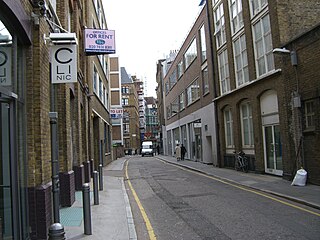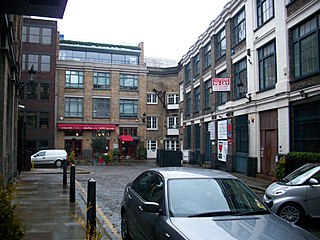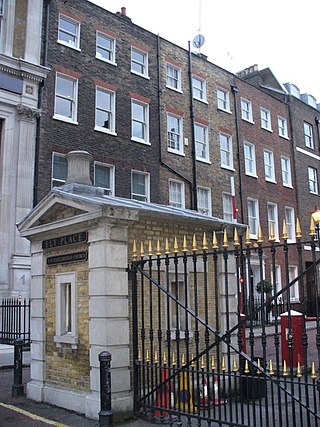
Scotland Yard is the headquarters of the Metropolitan Police, the territorial police force responsible for policing Greater London's 32 boroughs. Its name derives from the location of the original Metropolitan Police headquarters at 4 Whitehall Place, which had its main public entrance on the Westminster street called Great Scotland Yard. The Scotland Yard entrance became the public entrance, and over time "Scotland Yard" came to be used not only as the common name of the headquarters building, but also as a metonym for the Metropolitan Police Service (MPS) itself and police officers, especially detectives, who serve in it. The New York Times wrote in 1964 that, just as Wall Street gave its name to New York's financial district, Scotland Yard became the name for police activity in London.

The Piccadilly line is a deep-level London Underground line running from the north to the west of London. It has two branches, which split at Acton Town, and serves 53 stations. The line serves Heathrow Airport, and some of its stations are near tourist attractions such as Piccadilly Circus and Buckingham Palace. The District and Metropolitan lines share some sections of track with the Piccadilly line. Printed in dark blue on the Tube map, it is the fourth busiest line on the Underground network, with over 210 million passenger journeys in 2011/12.

Holborn is a district in central London, which covers the south-eastern part of the London Borough of Camden and a part of the Ward of Farringdon Without in the City of London.

Finsbury Park is a public park in the London neighbourhood of Haringey, north London, England. The park lies on the southern-most edge of the London Borough of Haringey. It is in the area formerly covered by the historic parish of Hornsey, succeeded by the Municipal Borough of Hornsey. It was one of the first of the great London parks laid out in the Victorian era. The park borders the neighbourhoods of Harringay, Finsbury Park, Stroud Green, and Manor House.

Pentonville Road is a road in Central London that runs west to east from Kings Cross to City Road at The Angel, Islington. The road is part of the London Inner Ring Road and part of the boundary of the London congestion charge zone.

Hatton Garden is a street and commercial zone in the Holborn district of the London Borough of Camden, abutting the narrow precinct of Saffron Hill which then abuts the City of London. It takes its name from Sir Christopher Hatton, a favourite of Queen Elizabeth I, who established a mansion here and gained possession of the garden and orchard of Ely Place, the London seat of the Bishops of Ely. It remained in the Hatton family and was built up as a stylish residential development in the reign of King Charles II. For some decades it often went, outside of the main street, by an alternative name St Alban's Holborn, after the local church built in 1861.

Saffron Hill is a street and former ward in Holborn, in the south eastern corner of the London Borough of Camden, between Farringdon Road and Hatton Garden. The name of the street derives from the fact that it was at one time part of an estate on which saffron grew. The ecclesiastical parish was St Peter, Saffron Hill, a daughter parish of Holborn, which is now combined with St Alban, Holborn.

Bleeding Heart Yard is a cobbled courtyard off Greville Street in the Holborn area of the London Borough of Camden. The courtyard is probably named after a 16th-century inn sign dating back to the Reformation that was displayed on a pub called the Bleeding Heart in nearby Charles Street. The inn sign showed the heart of the Virgin Mary pierced by five swords.
The Holborn Division was one of four divisions of the Hundred of Ossulstone, in the county of Middlesex, England. The other divisions were named Finsbury, Kensington and Tower.
A diamond district is an area where the cutting, polishing, and trade of diamonds and other gems takes place. There are a number of these districts around the world, including:

Charterhouse Street is a street on the north side of Smithfield in the City of London. The road forms part of the City’s boundary with the neighbouring London Boroughs of Islington and Camden. It connects Charterhouse Square and Holborn Circus, crossing Farringdon Road and running along a number of historical sites, including Smithfield Market.

Marylebone High Street is a shopping street in London, running sub-parallel to Baker Street and terminating at its northern end at the junction with Marylebone Road. Given its secluded location, the street has been described as "the hidden wonder of the West End" and it was voted "best street in London" in 2002 by listeners of BBC Radio 4, winning praise for its being "a haven in the middle of the frantic city".

St Katherine Coleman was a parish church in the City of London, situated in St Katherine's Row, on the south side of Fenchurch Street, in Aldgate Ward. Of medieval origin, it narrowly escaped destruction in the Great Fire of London in 1666, but was rebuilt in the eighteenth century. The church closed in November 1926 and was demolished soon afterwards.

Leather Lane is a street west of Hatton Garden, in the Holborn area of London. It is home to a well-used weekday market which specialises in clothing, footwear and fruit and vegetables. There are now many food retailers capitalising off the lunchtime trade offering a range of different foods from falafel wraps and burritos to hog roasts and jacket potatoes.

Saffron Hill, Hatton Garden, Ely Rents and Ely Place was a liberty and from 1866 to 1930 a civil parish in the metropolitan area of London, England. It was part of the ancient parish of St Andrew Holborn.

Cranebank is a Local Nature Reserve on the east bank of the River Crane in Hatton in the London Borough of Hounslow. It is owned and managed by Hounslow Council. It is also part of The Crane Corridor Site of Metropolitan Importance for Nature Conservation.

The Hatton Garden safe deposit burglary occurred in April 2015, when an underground safe deposit facility in Hatton Garden, London, owned by Hatton Garden Safe Deposit Ltd., was burgled.
Samuel Fisher, Baron Fisher of Camden was a British businessman, local politician and leading member of the Jewish community.

















